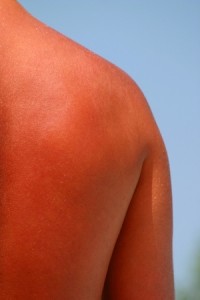 We’ve all done it at some point in our lives. Whether you forgot to wear sun protection, missed a spot, didn’t reapply the sunscreen, or underestimated the time you spent outdoors, the results are usually the same: red, inflamed and sore skin.
We’ve all done it at some point in our lives. Whether you forgot to wear sun protection, missed a spot, didn’t reapply the sunscreen, or underestimated the time you spent outdoors, the results are usually the same: red, inflamed and sore skin.
Here are five tips to treat sunburn, and potentially limit the damage in the long run:
1. Seek Cover
As soon as you see any signs of redness or feel the skin tingling, get out of the sun. It can take up to 24 hours for the symptoms to fully develop. Don’t apply more sunscreen, as some tend to do. If you are stuck out in the sun, cover up: put a shirt on, place a towel over your neck, or use whatever you can to protect the inflamed skin.
2. Moisturize
First take a cool shower or bath to relieve the pain of the sunburn. Then apply an unscented moisturizing lotion to soothe the skin and prevent it from drying out. Continual and ample application of lotion will help reduce the appearance of peeling, flaky skin. No matter how tempting it may be, do not remove the peeling skin or break any blisters.
3. Hydrate
Burns draw fluid to the skin surface, away from the rest of the body, so drink extra fluids for at least 48 hours after burning the skin. Also watch for signs of dehydration, such as thirst, decreased urination, headache, sleepiness and dizziness.
4. Medicate
The moment that you see sunburn signs emerging, take a dose of ibuprofen or aspirin. Continue dosing every four to six hours over the next 24 hours. This will help minimize the redness, swelling and pain that often accompany a burn. Note that acetaminophen also treats the pain, but doesn’t have the same anti-inflammatory effect.
5. Seek Help
If a blistering burn covers at least 20% of the body, be sure to seek medical attention. Fevers, chills or severe dehydration are also symptoms to immediately take to a medical professional.
When the sunburn has healed, take the time to reflect upon the incident in order to understand how it happened, and to ensure it doesn’t happen again. Each burn in your lifetime inflicts permanent sun damage, including photaging (i.e. pigmentation and wrinkles) and increases your risk of skin cancer.
Source: Skin Cancer Foundation